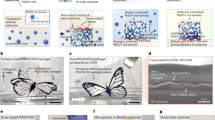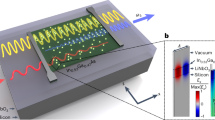Abstract
Nature uses mechanochemical transduction processes to achieve diverse and vital functions, such as hearing, cellular adhesion and gating of ion channels. One fascinating example of biological mechanotransduction is the emission of light on mechanical stimulation. However, molecular-level transduction of force into luminescence in a synthetic system remains a challenge. Here, we show that bis(adamantyl)-1,2-dioxetane emits visible light when force is applied to a polymer chain or network in which this unit is incorporated. Bright-blue luminescence was observed on sonication of solutions of dioxetane-containing linear polymers and on the straining of polymer networks with dioxetane crosslinkers. Light is emitted from the adamantanone-excited state that forms on opening of the four-membered dioxetane ring. Increased sensitivity and colour tuning were achieved by energy transfer to suitable acceptors. High spatial and temporal resolutions highlight the potential to study the failure of polymeric materials in unprecedented detail.
This is a preview of subscription content, access via your institution
Access options
Subscribe to this journal
Receive 12 print issues and online access
$259.00 per year
only $21.58 per issue
Buy this article
- Purchase on Springer Link
- Instant access to full article PDF
Prices may be subject to local taxes which are calculated during checkout



Similar content being viewed by others
References
Gillespie, P. G. & Walker, R. G. Molecular basis of mechanosensory transduction. Nature 413, 194–202 (2001).
Friedland, J. C., Lee, M. H. & Boettiger, D. Mechanically activated integrin switch controls α5β1 function. Science 323, 642–644 (2009).
Haddock, S. H. D., Moline, M. A. & Case, J. F. Bioluminescence in the sea. Annu. Rev. Mar. Sci. 2, 443–493 (2010).
Potisek, S. L., Davis, D. A., Sottos, N. R., White, S. R. & Moore, J. S. Mechanophore-linked addition polymers. J. Am. Chem. Soc. 129, 13808–13809 (2007).
Davis, D. A. et al. Force-induced activation of covalent bonds in mechanoresponsive polymeric materials. Nature 459, 68–72 (2009).
Piermattei, A., Karthikeyan, S. & Sijbesma, R. P. Activating catalysts with mechanical force. Nature Chem. 1, 133–137 (2009).
Caruso, M. M. et al. Mechanically-induced chemical changes in polymeric materials. Chem. Rev. 109, 5755–5798 (2009).
Beyer, M. K. & Clausen-Schaumann, H. Mechanochemistry: the mechanical activation of covalent bonds. Chem. Rev. 105, 2921–2948 (2005).
Black, A. L., Lenhardt, J. M. & Craig, S. L. From molecular mechanochemistry to stress-responsive materials. J. Mater. Chem. 21, 1655–1663 (2011).
Butyagin, P. Y. et al. About luminescence accompanied mechanical deformation and rupture of polymers. Vysokomol. Soed. A. 12, 290–299 (1970).
Dodeigne, C., Thunus, L. & Lejeune, R. Chemiluminescence as diagnostic tool. A review. Talanta 51, 415–439 (2000).
Rongen, H. A. H., Hoetelmans, R. M. W., Bult, A. & Van Bennekom, W. P. Chemiluminescence and immunoassays. J. Pharm. Biomed. Anal. 12, 433–462 (1994).
Schuster, G. B. et al. Adamantylideneadamantane-1,2-dioxetane. An investigation of the chemiluminescence and decomposition kinetics of an unusually stable 1,2-dioxetane. J. Am. Chem. Soc. 97, 7110–7118 (1975).
Meijer, E. W. & Wynbergl, H. The synthesis and chemiluminescence of a stable 1,2-dioxetane. J. Chem. Educ. 59, 1071–1072 (1982).
Turro, N. J. et al. Tetramethyl-1,2-dioxetane. Experiments in chemiexcitation, chemiluminescence, photochemistry, chemical dynamics, and spectroscopy. Acc. Chem. Res. 7, 97–105 (1974).
Beck, S. & Koster, H. Applications of dioxetane chemiluminescent probes to molecular biology. Anal. Chem. 62, 2258–2270 (1990).
Lenhardt, J. M., Black, A. L. & Craig, S. L. gem-Dichlorocyclopropanes as abundant and efficient mechanophores in polybutadiene copolymers under mechanical stress. J. Am. Chem. Soc. 131, 10818–10819 (2009).
Kryger, M. J., Munaretto, A. M. & Moore, J. S. Structure–mechanochemical activity relationships for cyclobutane mechanophores. J. Am. Chem. Soc. 133, 18992–18998 (2011).
Klukovich, H. M., Kean, Z. S., Iacono, S. T. & Craig, S. L. Mechanically induced scission and subsequent thermal remending of perfluorocyclobutane polymers. J. Am. Chem. Soc. 133, 17882–17888 (2011).
Wiggins, K. M., Syrett, J. A., Haddleton, D. M. & Bielawski, C. W. Mechanically facilitated retro [4+2]cycloadditions. J. Am. Chem. Soc. 133, 7180–7189 (2011).
Song, Y-K. et al. Fluorescence sensing of microcracks based on cycloreversion of a dimeric anthracene moiety. J. Mater. Chem. 22, 1380–1386 (2012).
Brantley, J. N., Wiggins, K. M. & Bielawski, C. W. Unclicking the click: mechanically facilitated 1,3-dipolar cycloreversions. Science 333, 1606–1609 (2011).
Percec, V. et al. Ultrafast synthesis of ultrahigh molar mass polymers by metal-catalyzed living radical polymerization of acrylates, methacrylates, and vinyl chloride mediated by SET at 25 °C. J. Am. Chem. Soc. 128, 14156–14165 (2006).
Bechara, E. J. H. & Wilson, T. Alkyl substituent effects on dioxetane properties. Tetraethyl-, dicyclohexylidene-, and 3,4-dimethyl-3,4-di-n-butyldioxetanes. A discussion of decomposition mechanisms. J. Org. Chem. 45, 5261–5268 (1980).
Brown, H. R. A molecular interpretation of the toughness of glassy polymers. Macromolecules 24, 2752–2756 (1991).
Mikos, A. G. & Peppas, N. A. Polymer chain entanglements and brittle fracture. J. Chem. Phys. 88, 1337–1342 (1988).
Mohammadi, N., Klein, A. & Sperling, L. H. Polymer chain rupture and the fracture behavior of glassy polystyrene. Macromolecules 26, 1019–1026 (1993).
Lee, C. K. et al. Force-induced redistribution of a chemical equilibrium. J. Am. Chem. Soc. 132, 16107–16111 (2010).
Acknowledgements
This work was supported by grants from the Netherlands Organization for Scientific Research. We thank H. J. Zhu for help with recording the videos, and L. E. Govaert and S. C. Meskers for helpful discussions.
Author information
Authors and Affiliations
Contributions
R.P.S. and E.W.M. conceived the concept, R.P.S. directed the research, Y.C., A.J.H.S., S.K. and G.W.M.P designed and performed the experiments and analysed the data. All of the authors participated in writing the paper.
Corresponding author
Ethics declarations
Competing interests
The authors declare no competing financial interests.
Supplementary information
Supplementary information
Supplementary information (PDF 847 kb)
Supplementary Movie 1
Supplementary Movie 1 (AVI 2233 kb)
Supplementary Movie 2
Supplementary Movie 2 (AVI 4409 kb)
Rights and permissions
About this article
Cite this article
Chen, Y., Spiering, A., Karthikeyan, S. et al. Mechanically induced chemiluminescence from polymers incorporating a 1,2-dioxetane unit in the main chain. Nature Chem 4, 559–562 (2012). https://doi.org/10.1038/nchem.1358
Received:
Accepted:
Published:
Issue Date:
DOI: https://doi.org/10.1038/nchem.1358
This article is cited by
-
Autonomous indication of electrical degradation in polymers
Nature Materials (2024)
-
Rational design multi-color-emissive chemiluminescent carbon nanodots in a single solvothermal reaction
Nano Research (2024)
-
Phosphorescent extensophores expose elastic nonuniformity in polymer networks
Nature Communications (2023)
-
Control of Fluorescence of Organic Dyes in the Solid-State by Supramolecular Interactions
Journal of Fluorescence (2023)
-
Double-Layer Hydrogels with Tunable Mechanofluorochromic Response for Smart Display
Chinese Journal of Polymer Science (2023)



